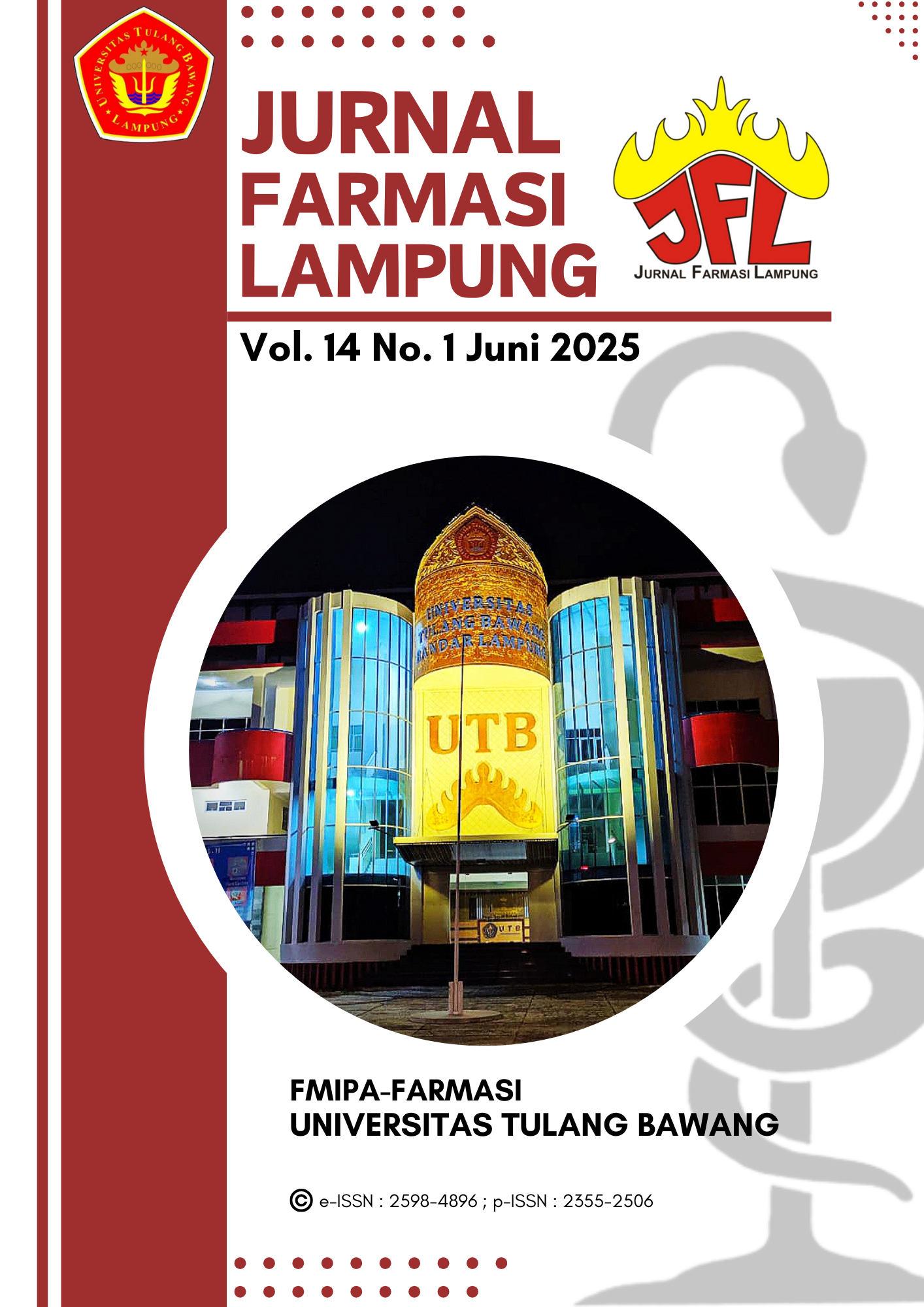ANALISIS KUANTITATIF KANDUNGAN MERKURI (Hg) PADA PRODUK BEDAK PEMUTIH YANG BEREDAR DI KOTA BATAM
QUANTITATIVE DETERMINATION OF MERCURY (Hg) LEVELS IN WHITENING POWDERS DISTRIBUTED IN BATAM CITY
DOI:
https://doi.org/10.37090/jfl.v14i1.2404Abstract
Cosmetics are ingredients or mixtures of ingredients to be used on parts of the human body with the intention of cleansing, protecting to keep it in good condition and can play a role in healing and skin care. Facial cosmetic products that are currently often used are powder. There are various forms of powder, one of which is whitening powder which is widely discussed not only the product that floods the market, but also because of the impact of using the product which is able to whiten and brighten the face in a very short time. The content contained in these products also varies, some are formulated safe to use and dangerous when used. One of them is that mercury (Hg) is usually added intentionally or not very unjustified because it will be in direct contact with the skin and can be toxic. This study aims to identify the content of Mercury (Hg) in whitening surgery circulating in Batam City using the FIMS (Flow Injection Mercury System) test method. The results of research conducted on 10 whitening powder samples obtained mercury (Hg) levels with the largest average value, namely in the Px sample code with a value of 0.924 mg/kg, while the smallest average value was in the Lv sample code with a value of 0.021 mg/kg. In the test, there is a mercury content, but no one exceeds the maximum limit for cosmetics set by BPOM, which in BPOM regulations regarding metal contamination requirements in cosmetics containing mercury (Hg) is no more than 1 mg/kg, so it is safe to use.
Keywords: Cosmetics, whitening powder, mercury, FIMS (Flow Injection Mercury System), Hg
Downloads
References
[1] Effendi, N., M. Pratama dan H. Kamaruddin. 2014. Analisis Kandungan Logam Berat Merkuri (Hg) Dan Timbal (Pb) Pada Kosmetik Lipstik Yang Beredar Di Kota Makasar Dengan Metode Spektrofotometri Serapan Atom. As-Syifaa, 6(1): 82-90.
[2] Tandiarang M. Kosmetik Bedak [Internet]. Makassar: mardiantitandiarrang.com; 2011 [cited 2023 Mar 10]. Available from: http://mardiantitandiarrang.com/2011/02/kosmetik-bedak.html
[3] Erasiska, S. Bali dan T.A. Hanifah. 2015. Analisis Kandungan Logam Timbal, Kadmium Dan Merkuri Dalam Produk Krim Pemutih Wajah. Jurnal Online Mahasiswa (JOM) Bidang Matematika dan Ilmu Pengetahuan Alam. 2(1): 123-129.
[4] Chakti, A.S., E.S. Simaremare, dan R.D. Pratiwi. 2019. Analisis Merkuri Dan Hidrokuinon Pada Krim Pemutih Yang Beredar Di Jayapura. Jurnal Sains dan Teknologi, 8(1): 1-11.
[5] Kartikorini, N. 2018. Variasi Kandungan Merkuri (Hg) Pada Berbagai Macam Bedak Whitening Yang Dijual Pasar Blauran Surabaya. Lembaga Penelitian dan Pengabdian Masyarakat. Universitas Muhammadiyah Surabaya.
[6] Wan Dewi Marini. Identifikasi kandungan senyawa merkuri (Hg) pada kosmetik pemutih wajah tidak berizin yang beredar di Kota Batam [skripsi]. Batam: Program Studi Farmasi. STIKes Mitra Bunda Persada Batam; 2019.
[7] Livia. Pengujian Kandungan Merkuri Dalam Sediaan Kosmetik Dengan Spektrofotometri Serapan Atom [Skripsi]. Bandung: Universitas Islam Bandung; 2011.
[8] Kementerian Kesehatan Republik Indonesia. Peraturan Menteri Kesehatan RI No. 445/Menkes/Per/V/1998 tentang Persyaratan Cemaran Logam Berat pada Kosmetik. Jakarta: Kementerian Kesehatan RI; 1998.
[9] Badan Pengawas Obat dan Makanan Republik Indonesia. Persyaratan Teknis Bahan Kosmetika [Internet]. Jakarta: BPOM RI; 2020 [cited 2023 Mar 10]. Available from: https://www.pom.go.id
[10] Triyati Etty. 2012. Spektrofotometer Ultra-Violet dan Sinar Tampak Serta Aplikasinya Dalam Oseanologi. Oseana, Vol 10: 39-47.
[11] Skoog, D.A., West, D.M., Holler, F.J., & Crouch, S.R. Fundamentals of Analytical Chemistry.
[12] Amir. MT. 2016. Inovasi Pendiidkan Melalui Problem Based Learning. Jakarta: PT Fajar Interpratama Mandiri.
[13] Dewi, M. dan N. Suriana. 2013. A-Z Tentang Kosmetik. Gramedia Pustaka, Jakarta.
[14] Gandjar, G. I., dan Rohman, A,. 2007. Kimia Farmasi Analisis. Pustaka Belajar. Yogyakarta.
[15] Silva Fatima, Toth I, Rangel A. 2006. Determination of Mercury in Fish by Cold Vapor Atomic Absorption Specthrophotometry Using a Multicommuted Flow Injection Analysis System. The Japan Society for Analytical Chemistry.
[16] Hineman Aaron. 2012. Determination of As, Se and Hg in Waters by Hydride Generation/Cold Vapor Atomic Absorption Spectroscopy. Perkin Elmer Inc.
[17] Anonim. 2012. FIAS (Flow Injection for Atomic Spectroscopy). PerkinElmer. Inc.
[18] Sin, K.W., dan H.F Tsang. 2003. Large-scale mercury exposure due to a cream cosmetic community-wide case series. Hong Kong Medicine Journal. 9(5): 329-334.
[19] Rahmi, S. 2017. Identifikasi Senyawa Hidroquinon Dan Merkuri Pada Krim Kecantikan Yang Beredar Di Pasaran. Jurnal Penelitian Pendidikan MIPA. 2(1): 118-122.









